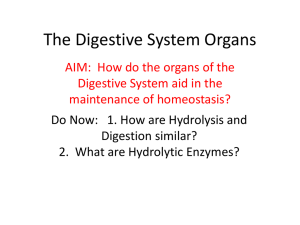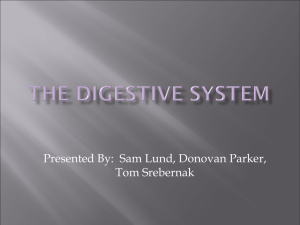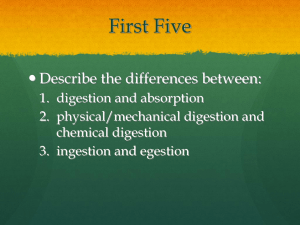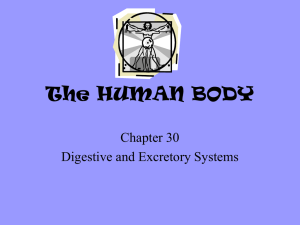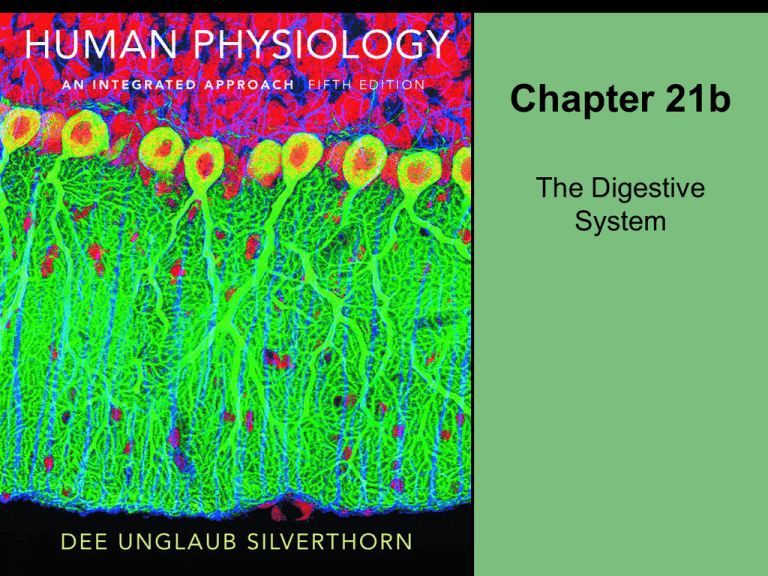
Chapter 21b
The Digestive
System
Regulation of GI Function
• Long reflexes integrated in CNS
• Short reflexes integrated in ENS
• Reflexes involving GI peptides / Hormones
Regulation of GI Function
• Integration of long and short reflexes in the
digestive system
KEY
External
stimulus
Stimulus
Receptor
Integrating
center
Efferent path
(sight, smell,
etc.)
Sensory
receptors
Tissue
response
Short reflexes
Long reflexes
The
cephalic
brain
Sympathetic and
parasympathetic
neurons
Local
stimulus
(pH, stretch,
osmolarity,
products of
digestion)
Neurons
of
Intermyenteric
neurons
and
submucosal
plexuses
Enteric nervous system
Sensory
receptors
and
neurons
“The little brain”
Smooth
muscles
or
secretory
cells
Muscle contraction/relaxation
or
Exocrine secretion (enzymes, mucus,
acid, bicarbonate), paracrines
or
Endocrine secretions
Effectors
Digestive system responses
Figure 21-11
Regulation of GI Function
KEY
Stimulus
Receptor
Integrating
center
Efferent path
Tissue
response
Local
stimulus
(pH, stretch,
osmolarity,
products of
digestion)
Sensory
receptors
and
neurons
Interneurons
Neurons
of
myenteric
and
submucosal
plexuses
Enteric nervous system
“The little brain”
Short reflexes
Smooth
muscles
or
secretory
cells
Muscle contraction/relaxation
or
Exocrine secretion (enzymes, mucus,
acid, bicarbonate), paracrines
or
Endocrine secretions
Effectors
Digestive system responses
Figure 21-11 (1 of 3)
Regulation of GI Function
KEY
External
stimulus
Stimulus
Receptor
Integrating
center
Efferent path
(sight, smell,
etc.)
Sensory
receptors
Tissue
response
Long reflexes
The
cephalic
brain
Sympathetic and
parasympathetic
neurons
Local
stimulus
(pH, stretch,
osmolarity,
products of
digestion)
Sensory
receptors
and
neurons
Neurons
of
myenteric
and
submucosal
plexuses
Enteric nervous system
“The little brain”
Smooth
muscles
or
secretory
cells
Muscle contraction/relaxation
or
Exocrine secretion (enzymes, mucus,
acid, bicarbonate), paracrines
or
Endocrine secretions
Effectors
Digestive system responses
Figure 21-11 (2 of 3)
Regulation of GI Function
KEY
External
stimulus
Stimulus
Receptor
Integrating
center
Efferent path
(sight, smell,
etc.)
Sensory
receptors
Tissue
response
Short reflexes
Long reflexes
The
cephalic
brain
Sympathetic and
parasympathetic
neurons
Local
stimulus
(pH, stretch,
osmolarity,
products of
digestion)
Sensory
receptors
and
neurons
Interneurons
Neurons
of
myenteric
and
submucosal
plexuses
Enteric nervous system
“The little brain”
Smooth
muscles
or
secretory
cells
Muscle contraction/relaxation
or
Exocrine secretion (enzymes, mucus,
acid, bicarbonate), paracrines
or
Endocrine secretions
Effectors
Digestive system responses
Figure 21-11 (3 of 3)
Regulation of GI Function
• Reflexes involving GI Peptides
Overview of GI Reflexes
Stimuli
Receptor/
integrating
center
Cephalic phase of digestion (feedforward)
Distension
Acid
Presence of food
Secretory cells of the
stomach and small intestine
Efferent
pathway
GI peptides
Effectors
GI smooth muscle
Exocrine cells of stomach, pancreas, intestine
Other endocrine cells
Nervous system
Responses
Changes in GI motility
Release of bile and pancreatic secretions
Enzyme, acid, and bicarbonate
synthesis/release
Hunger/satiety
Figure 21-12
ENS Shares Features with CNS
•
•
•
•
•
Intrinsic neurons
Neurotransmitters and neuromodulators
Support cells
Diffusion barrier
Integrating center
Digestive Hormones
• Gastrin family
• Gastrin and CCK
• Secretin family
• Secretin, VIP, GIP, and GLP-1
• Others
• Motilin
Secretin
CCK
Fats and Proteins in SI
Bile
Pancreatic enzymes
•Trypsin
•Chymotrypsin
•Procarboxypepsidase
Bicarbonate ions
Control of the Digestive System
PLAY
Interactive Physiology® Animation: Digestive System:
Control of the Digestive System
Digestion and Absorption
Brush border
Microvilli
• A villus and a crypt
in the small intestine
Enterocyte
Enterocytes
Capillaries
Goblet cells
Crypt
lumen
Lacteals
Lamina propria
Endocrine cells
Muscularis mucosae
Figure 21-13
Digestion and Absorption
• Carbohydrates break down into
monosaccharides
Glucose polymers
digest to
Starch, glycogen
Disaccharides
Amylase
Maltose
Maltase
2 glucose
Sucrose
Lactose
Sucrase
Lactase
1 glucose + 1 glucose +
1 fructose
1 galactose
Monosaccharides
Figure 21-14
Digestion and Absorption
• Carbohydrate absorption in the small
intestine
Lumen of
intestine
Na+
Glucose or
galactose
Fructose
Na+
Intestinal
mucosa
K+
Glucose enters the cell with Na+ on the
SGLT symporter and exits on GLUT2.
Fructose enters on GLUT5 and exits
on GLUT2.
KEY
SGLT
GLUT2
GLUT5
Figure 21-15
Digestion and Absorption
Amino
acids
Aminoterminal end
• Enzymes for protein
digestion
Peptide
bonds
Carboxyterminal end
H2N
COOH
(a) Peptide structure
Endopeptidase
digests internal
peptide bonds.
+H2O
COOH
H2N
H2N
H2N
COOH
(b)
COOH
2 smaller peptides
Exopeptidase digests terminal peptide
bonds to release amino acids.
Aminopeptidase
Carboxypeptidase
+H2O
+H2O
COOH
H2N
H2N
COOH
H2N
Amino acid
(c)
COOH
Amino acid
H2N
COOH
Peptide
Figure 21-16
Digestion and Absorption
• Peptide absorption
Proteins
Peptides
Di- and tripeptides
cotransport with H+.
H+
H+
Amino acids
cotransport
with Na+.
Small peptides
are carried intact
across the cell by
transcytosis.
Na+
Na+
Peptidases
K+
ATP
H+
Blood
Na+
Na+
To the liver
Figure 21-17
Digestion and Absorption
• Triglycerides digest into monoglycerides and
free fatty acids
Triglyceride
Lipase, colipase
+
Monoglyceride
Free fatty acids
Figure 21-18
Digestion and Absorption
• Bile salts emulsify fats
Bile salt-coated
lipid droplet
Water
Hydrophobic side
associates
with lipids.
(a)
Polar side chains
(hydrophilic side
associates with
water)
Bile
salt
Free fatty acids
Cholesterol
Bile
salt
Monoglyceride Phospholipids Diglyceride
(b)
Figure 21-19
Digestion and Absorption of Fats
Bile salts
from liver
1
Large fat
droplets from
stomach
2 Pancreatic lipase and colipase break down fats into
monoglycerides and fatty
acids stored in micelles.
Emulsion
Bile salts
recycle
Lipase 22
and colipase
Micelles
Lumen of
small intestine
3a
1 Bile salts from liver
coat fat droplets.
3a Monoglycerides and fatty
acids move out of micelles
and enter cells by diffusion.
3b Cholesterol is transported
into cells by a membrane
transporter.
3b
4 Absorbed fats combine with
cholesterol and proteins in
the intestinal cells to form
chylomicrons.
Smooth
ER
4 Triglycerides + cholesterol + protein
Cells of
small
intestine
Chylomicron
5 Chylomicrons are released
into the lymphatic system.
Golgi
apparatus
5
Interstitial
fluid
Capillary
Lacteal
Lymph
to
vena
cava
Figure 21-20
Digestion and Absorption of Fats
Bile salts
from liver
1
1 Bile salts from liver
coat fat droplets.
Large fat
droplets from
stomach
Emulsion
Lumen of
small intestine
Cells of
small
intestine
Interstitial
fluid
Capillary
Lacteal
Figure 21-20, step 1
Digestion and Absorption of Fats
Bile salts
from liver
1
Large fat
droplets from
stomach
Emulsion
Lumen of
small intestine
1 Bile salts from liver
coat fat droplets.
2 Pancreatic lipase and colipase break down fats into
monoglycerides and fatty
acids stored in micelles.
Lipase 22
and colipase
Micelles
Cells of
small
intestine
Interstitial
fluid
Capillary
Lacteal
Figure 21-20, steps 1–2
Digestion and Absorption of Fats
Bile salts
from liver
1
Large fat
droplets from
stomach
2 Pancreatic lipase and colipase break down fats into
monoglycerides and fatty
acids stored in micelles.
Emulsion
Lumen of
small intestine
Lipase 22
and colipase
Micelles
1 Bile salts from liver
coat fat droplets.
Bile salts
recycle
3a Monoglycerides and fatty
acids move out of micelles
and enter cells by diffusion.
3a
Cells of
small
intestine
Interstitial
fluid
Capillary
Lacteal
Figure 21-20, steps 1–3a
Digestion and Absorption of Fats
Bile salts
from liver
1
Large fat
droplets from
stomach
2 Pancreatic lipase and colipase break down fats into
monoglycerides and fatty
acids stored in micelles.
Emulsion
Lumen of
small intestine
Lipase 22
and colipase
Micelles
3a
3b
1 Bile salts from liver
coat fat droplets.
Bile salts
recycle
3a Monoglycerides and fatty
acids move out of micelles
and enter cells by diffusion.
3b Cholesterol is transported
into cells by a membrane
transporter.
Cells of
small
intestine
Interstitial
fluid
Capillary
Lacteal
Figure 21-20, steps 1–3b
Digestion and Absorption of Fats
Bile salts
from liver
1
Large fat
droplets from
stomach
2 Pancreatic lipase and colipase break down fats into
monoglycerides and fatty
acids stored in micelles.
Emulsion
Lipase 22
and colipase
Micelles
Lumen of
small intestine
3a
1 Bile salts from liver
coat fat droplets.
Bile salts
recycle
3b
3a Monoglycerides and fatty
acids move out of micelles
and enter cells by diffusion.
3b Cholesterol is transported
into cells by a membrane
transporter.
4 Absorbed fats combine with
cholesterol and proteins in
the intestinal cells to form
chylomicrons.
Smooth
ER
4 Triglycerides + cholesterol + protein
Cells of
small
intestine
Chylomicron
Interstitial
fluid
Capillary
Lacteal
Figure 21-20, steps 1–4
Digestion and Absorption of Fats
Bile salts
from liver
1
Large fat
droplets from
stomach
2 Pancreatic lipase and colipase break down fats into
monoglycerides and fatty
acids stored in micelles.
Emulsion
Bile salts
recycle
Lipase 22
and colipase
Micelles
Lumen of
small intestine
3a
1 Bile salts from liver
coat fat droplets.
3a Monoglycerides and fatty
acids move out of micelles
and enter cells by diffusion.
3b Cholesterol is transported
into cells by a membrane
transporter.
3b
4 Absorbed fats combine with
cholesterol and proteins in
the intestinal cells to form
chylomicrons.
Smooth
ER
4 Triglycerides + cholesterol + protein
Cells of
small
intestine
Chylomicron
5 Chylomicrons are released
into the lymphatic system.
Golgi
apparatus
5
Interstitial
fluid
Capillary
Lacteal
Lymph
to
vena
cava
Figure 21-20, steps 1–5
Digestion and Absorption
• Nucleic acids are digested into nitrogenous
bases and monosaccharides
• Intestine absorbs vitamins and minerals
• Fat-soluble absorbed with fats
• Water-soluble by mediated transport
• Vitamin B12 when complexed to intrinsic factor and
absorbed in ileum
• Mineral by active transport
Digestion and Absorption
• NaCl reabsorption in the small intestine and
colon
Lumen of
small intestine
or colon
Intestinal cell
Interstitial
fluid
K+
1
Na+
2
Na+
Na+
reabsorbed.
Na+
Cl–
ATP
Na+
K+
H+
HCO3–
Cl–
Cl–
1 Na+ enters cells by
multiple pathways.
2
The Na+-K+-ATPase pumps
Na+ into the ECF.
Figure 21-21
Digestion and Absorption
• Summary of motility, secretion, digestion, and
absorption in different regions of the digestive
system
KEY
M: motility
S:secretion
D:digestion
A:absorption
Salivary gland
Upper esophageal
sphincter
Esophagus
Lower esophageal
sphincter
Liver
ORAL CAVITY AND ESOPHAGUS
M: swallowing, chewing
S:saliva (salivary glands), lipase
D:carbohydrates, fats (minimal)
A:none
STOMACH
M:peristaltic mixing and propulsion
S:HCl (parietal cells); pepsinogen and gastric lipase
(chief cells); mucus and HCO3– (surface mucous cells);
gastrin (G cells); histamine (EC cells)
D:proteins, fats
A:lipid-soluble substances such as alcohol and aspirin
SMALL INTESTINE
Gallbladder
Pylorus
Pancreas
Ileocecal valve
Rectum
Anal sphincters
M:mixing and propulsion primarily by segmentation
S:enzymes; HCO3– and enzymes (pancreas); bile (liver);
mucus (goblet cells); hormones: CCK, secretin, GIP,
and other hormones
D:carbohydrates, fats, polypeptides, nucleic acids
A:peptides by active transport; amino acids, glucose,
and fructose by secondary active transport;
fats by simple diffusion; water by osmosis ions,
minerals, and vitamins by active transport
LARGE INTESTINE
M:segmental mixing; mass movement for propulsion
S:mucus (goblet cells)
D:none (except by bacteria)
A:ions, water, minerals, vitamins, and small organic
molecles produced by bacteria
Figure 21-22
Digestion and Absorption
PLAY
Interactive Physiology® Animation: Digestive System:
Digestion and Absorption


